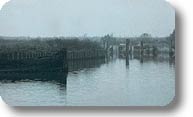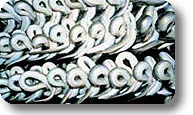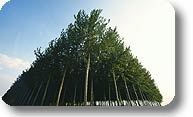|
Typical Products
|
 |
The territory of Parco del Delta del Po presents all the typical characteristics of valley environments. The stories of the delta’s inhabitants have always mingled with the vicissitudes and the course of this changeable river, and they are still present and lively today. Fishing, in all its varieties – valley, sea and fresh-water fishing – still represents the fundamental feature of this territory crossed by thousands of brooks, inlets, fresh-water basins and rivers communicating with the sea.
Further information
|
|
Fishing in the Delta
|
 |
Besides fishing, this water landscape was marked by the processing of reeds : reeds were used to make coverings and roofs for the buildings inside the lagoon, as well as for matting, bags, "grisola" (a vegetable material) and "moulds" for hunting – e.g. reed-made swamp birds. The different fish species caught by the "lavoriero" (an ancient fishing tool), especially the delicious eels and big-scale sand-smelts, were then cooked following the tradition, either marinated or fried. At Azienda Valli, a firm in Comacchio, women were charged of the processing of eels following a precise production cycle : eels were cooked on the spit, marinated with a mixture of vinegar, water, salt and laurel leaves and, finally, they were put into typical wood containers called "zangolini". |
|
White Gold
|
|
This land is rich in water, but also in salt, the "white gold". The brackish water was progressively decanted from one natural salt basin to another, and huge quantities of white crystals were produced in the salt works of Comacchio and Cervia. The fish coming from the sea and the valley – such as eels and sardines - is still nowadays covered with salt according to the tradition. |
|
And Wine...
|
 |
The territory between the river Po’s mouths and Goro in the north, and from the mouth of the river Reno down to the shores of the municipalities of Ravenna and Cervia, is the area of the Wood wines, and the Romea route that crosses it is also known as "strada dei vini del Bosco" (the route of the Wood wines). The "golden grapes" grapevine can trace its roots back to history : it is said that some cuttings of the Cote d’Or grapevine from Burgundy were transplanted into the sandy lands of the delta on the occasion of the wedding between Renata from France and Ercole II d’Este. From the first grape harvests in the 16th century up to recent times : in 1989 the four local wines – Fortana and Merlot as red wines, Sauvignon and Bianco as white wines - have received the DOC wine appellation. At present, their production area is situated within the Provinces of Ferrara (in Goro, Mesola, Lagosanto, and partly in the towns of Comacchio, Argenta and Codigoro) and Ravenna (in Ravenna and Cervia). |
|
|
|
You will find further information in:
Atlante dei Prodotti Tipici dei Parchi (Italian text)
an atlas dealing with the extraordinary heritage of typicality and tradition deriving from the knowledge and the professions created by the centuries-old presence of man. The atlas is edited by Slow Food, sponsored by Ministero dell'Ambiente e della Tutela del territorio and supported by Federparchi and Legambiente.
|




